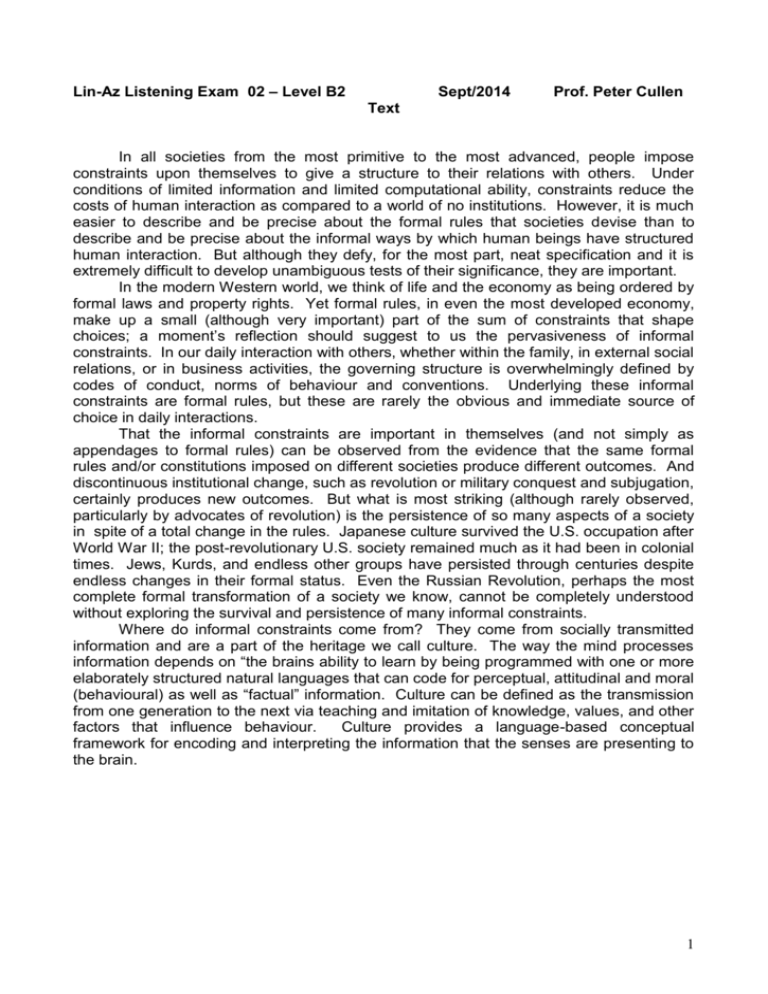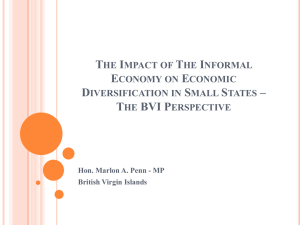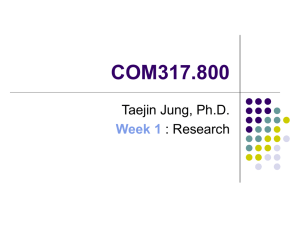LinAZ B2 Listening Exam 2 09 2014
advertisement

Lin-Az Listening Exam 02 – Level B2 Sept/2014 Prof. Peter Cullen Text In all societies from the most primitive to the most advanced, people impose constraints upon themselves to give a structure to their relations with others. Under conditions of limited information and limited computational ability, constraints reduce the costs of human interaction as compared to a world of no institutions. However, it is much easier to describe and be precise about the formal rules that societies devise than to describe and be precise about the informal ways by which human beings have structured human interaction. But although they defy, for the most part, neat specification and it is extremely difficult to develop unambiguous tests of their significance, they are important. In the modern Western world, we think of life and the economy as being ordered by formal laws and property rights. Yet formal rules, in even the most developed economy, make up a small (although very important) part of the sum of constraints that shape choices; a moment’s reflection should suggest to us the pervasiveness of informal constraints. In our daily interaction with others, whether within the family, in external social relations, or in business activities, the governing structure is overwhelmingly defined by codes of conduct, norms of behaviour and conventions. Underlying these informal constraints are formal rules, but these are rarely the obvious and immediate source of choice in daily interactions. That the informal constraints are important in themselves (and not simply as appendages to formal rules) can be observed from the evidence that the same formal rules and/or constitutions imposed on different societies produce different outcomes. And discontinuous institutional change, such as revolution or military conquest and subjugation, certainly produces new outcomes. But what is most striking (although rarely observed, particularly by advocates of revolution) is the persistence of so many aspects of a society in spite of a total change in the rules. Japanese culture survived the U.S. occupation after World War II; the post-revolutionary U.S. society remained much as it had been in colonial times. Jews, Kurds, and endless other groups have persisted through centuries despite endless changes in their formal status. Even the Russian Revolution, perhaps the most complete formal transformation of a society we know, cannot be completely understood without exploring the survival and persistence of many informal constraints. Where do informal constraints come from? They come from socially transmitted information and are a part of the heritage we call culture. The way the mind processes information depends on “the brains ability to learn by being programmed with one or more elaborately structured natural languages that can code for perceptual, attitudinal and moral (behavioural) as well as “factual” information. Culture can be defined as the transmission from one generation to the next via teaching and imitation of knowledge, values, and other factors that influence behaviour. Culture provides a language-based conceptual framework for encoding and interpreting the information that the senses are presenting to the brain. 1 Lin-Az Listening Exam 02 – Level B2 Sept/2014 Prof. Peter Cullen ___________________________________________ Name, Date, and Registration Number Questions: Answer all 5 of the following questions. SIMPLE AND CORRECT IS BETTER THAN COMPLICATED AND WRONG. USE SHORT PHRASES AND SENTENCES. This exam requires interpretation and analysis. It is designed to test your ability to apply what you hear to possible discussion areas. 1. Why do humans self-impose constraints on their behaviour? 2. What is the relationship between formal rules and choice-making? 3. Why is it true that the same formal rules applied to different populations create different results? 4. What do the examples of the Japanese post-WWII and U.S. post-colonial societies illustrate? 5. What is the relationship between informal constraints and culture? 2 Lin-Az Listening Exam 02 – Level B2 Sept/2014 Prof. Peter Cullen Answer Sheet 1. Why do humans self-impose constraints on their behaviour? to give a structure to their relations with others 2. What is the relationship between formal rules and choice-making? Yet formal rules, in even the most developed economy, make up a small (although very important) part of the sum of constraints that shape choices 3. Why is it true that the same formal rules applied to different populations create different results? That the informal constraints are important in themselves (and not simply as appendages to formal rules) can be observed from the evidence that the same formal rules and/or constitutions imposed on different societies produce different outcomes 4. What do the examples of the Japanese post WWII and U.S. post-colonial societies illustrate? the persistence of so many aspects of a society in spite of a total change in the rules. 5. What is the relationship between informal constraints and culture? Where do informal constraints come from? They come from socially transmitted information and are a part of the heritage we call culture. 3






